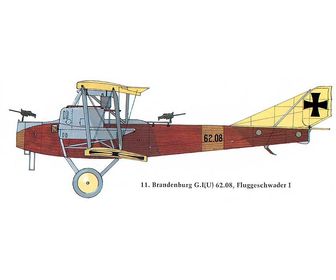Hansa-Brandenburg G.I

Picture has been licensed under a Creative Commons Attribution-Share Alike license.
Original source: Transferred from en.wikipedia; transferred to Commons by User:JuergenKlueser using CommonsHelper. (Original text : http://wp.scn.ru/en/ww1/b/1852/175/0#3) Author M.Zhirokhov. Original uploader was Rof operator at en.wikipedia Permission (Reusing this file) CC-BY-SA-3.0. (Original text : free image)
Author: M.Zhirokhov. Original uploader was Rof operator at en.wikipedia Permission (Reusing this file) CC-BY-SA-3.0. (Original text : free image)
Original source: Transferred from en.wikipedia; transferred to Commons by User:JuergenKlueser using CommonsHelper. (Original text : http://wp.scn.ru/en/ww1/b/1852/175/0#3) Author M.Zhirokhov. Original uploader was Rof operator at en.wikipedia Permission (Reusing this file) CC-BY-SA-3.0. (Original text : free image)
Author: M.Zhirokhov. Original uploader was Rof operator at en.wikipedia Permission (Reusing this file) CC-BY-SA-3.0. (Original text : free image)
The Hansa-Brandenburg G. I was a bomber aircraft used to equip the Austro-Hungarian aviation corps in World War I. It was a mostly conventional large three-bay biplane with staggered wings of slightly unequal span. The pilot and bombardier sat in a large open cockpit at the nose of the aircraft with a second open cockpit for a gunner in a dorsal position behind the wings. An unusual feature was the placement of the twin tractor engines.
Made by Hansa-BrandenburgUfag.
Empty Weight Lb
3915
Wing Area Sqm
70
Designer
Ernst Heinkel
Eng 1 Type
Austro-Daimler
Max Speed Mph
82
Eng 1 Kw
120
Introduced
1917
Max Speed Kmh
133
Gross Weight Lb
6040
Number Built
ca. 50
Crew
Three - pilot
bombardier
and gunner
Climb Rate Ftmin
330
Empty Weight Kg
1776
Gross Weight Kg
2740
Armament
480.0
Bombs
Span M
18
Primary user
Climb Rate Ms
2
Manufacturer
Met Or Eng
met
First Flight
early
Production End Year
1917
Span In
1
Span Ft
59
Wing Area Sqft
753
Production Start Year
1917
Length Ft
32
Eng 1 Hp
160
Eng 1 Number
2
Produced
1917
Length In
2
Length M
10
Category
